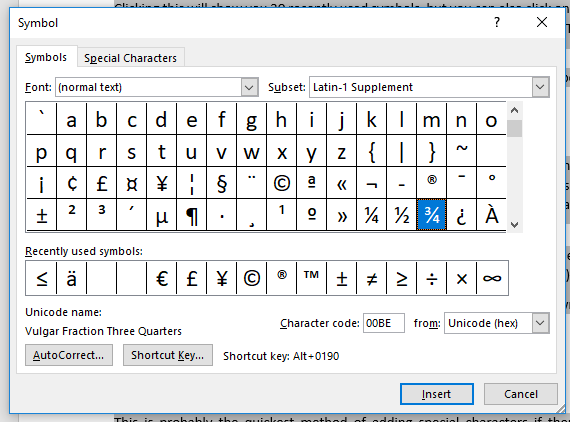- 3-minute read
- 10th July 2018
3 Ways to Add Special Characters in Microsoft Word
What makes a character special? Well, in this context, it means not being part of a standard keyboard. And while that might not sound especially special, it does make them trickier to use in a Microsoft Word document. Here, then, is a quick guide on how to use special characters in your writing.
1. Shortcuts and Autocorrect
Some symbols are common enough that Microsoft Word has default shortcuts for them. There are also some character combinations that autocorrect to a special character. These include:
Special Character | Shortcut | Autocorrect Option |
Trademark symbol (™) | Ctrl + Alt + T | Write ‘TM’ in parentheses |
Registered trademark symbol (®) | Ctrl + Alt + R | ‘R’ in parentheses |
Copyright symbol (©) | Ctrl + Alt + C | ‘C’ in parentheses |
Closed Ellipsis (…) | Ctrl + Alt + . | Three full stops without spaces |
Euro (€) | Ctrl + Alt + E | ‘E’ in parentheses |
So, to quickly add a copyright symbol to a document, we could either:
Find this useful?
Subscribe to our newsletter and get writing tips from our editors straight to your inbox.
Subscribe to Beyond the Margins and get your monthly fix of editorial strategy, workflow tips, and real-world examples from content leaders.
- Type the letter ‘c’ in brackets and let Word autocorrect it to the © symbol
- Hold down Ctrl + Alt + C to insert the character directly
There are also shortcuts for many accented letters, which can be useful if using foreign loanwords.
2. The Symbol Menu
For a fuller look at the special characters available to use, we need to open the Symbol menu.

Clicking this will show you the 20 most recently used symbols, but you can also click on More Symbols… to open a pop-up window that includes every character available in Microsoft Word. To use this:
- Place the cursor where you need to add a special character

The full character set. - Go to Insert > Symbols > Symbol > More Symbols… on the main ribbon (or Insert > Advanced Symbol > Symbols via the dropdown menus in Word for Mac)
- Find and select the character you want to use
- Click Insert to add it to your document in the chosen location
After you have used a symbol, it will be added to the quick access menu in case you need to use it again. You can also use the AutoCorrect… and Shortcut Key… options in this menu to give yourself a quick way to add specific symbols to a document (like those outlined for © and similar above).
3. Special Character Codes
Finally, you can also use special character codes to add a symbol to a document. These rely on having a keyboard with a numeric keypad (usually found on the right of a keyboard).
They trick here is that every special character has its own code number, known as an ASCII code. If you have the ASCII code for a symbol, you can then add it to a document by:
- Selecting where you want the symbol to appear with your cursor
- Turning on Num Lock
- Holding down the Alt key and typing the correct code
This is probably the quickest method of adding special characters if there are symbols you use frequently and you can remember the codes. But in most cases, or if you are using a laptop without a numeric keypad, it will be simpler to look up the character you need in the Symbols menu.





